1999 DODGE RAM belt
[x] Cancel search: beltPage 625 of 1691
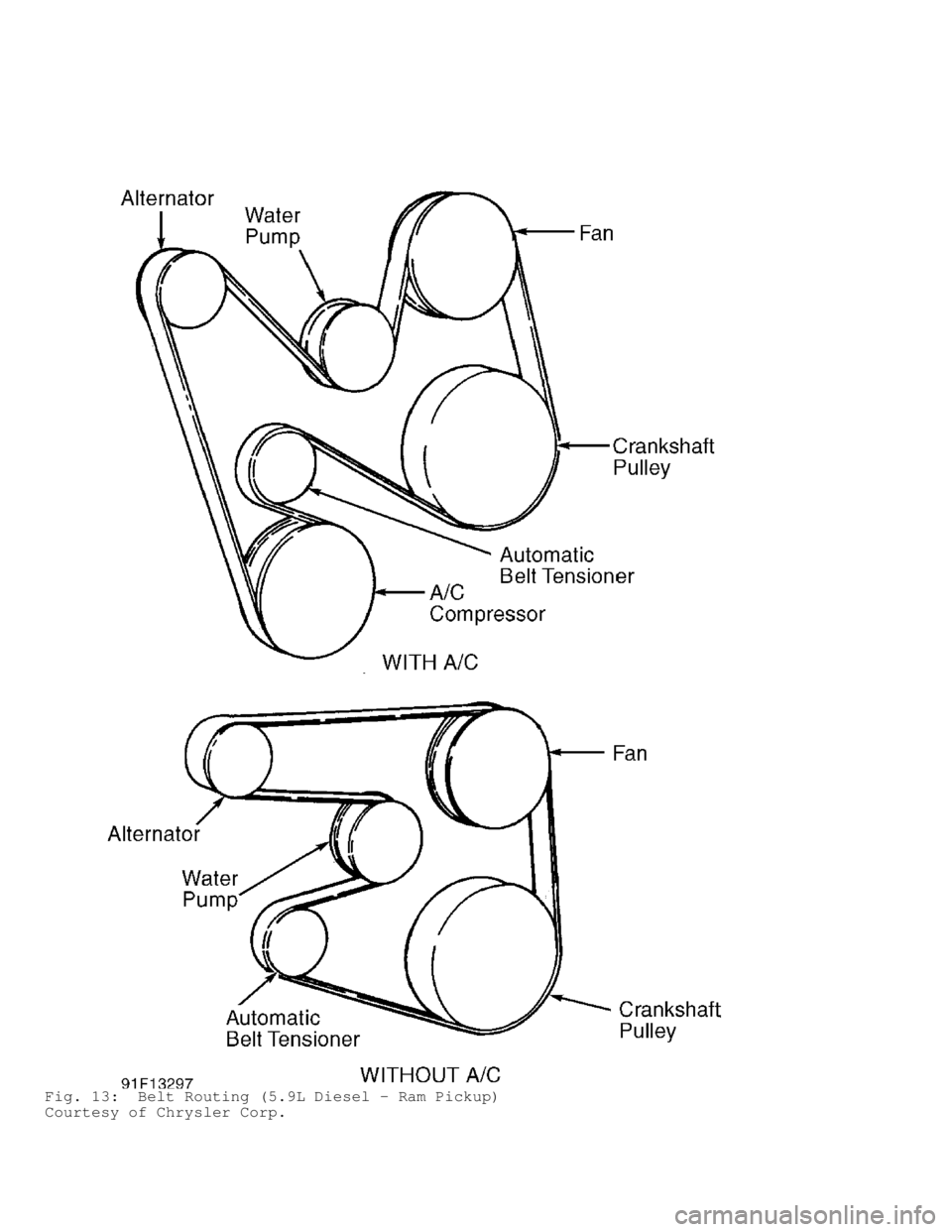
Fig. 13: Belt Routing (5.9L Diesel - Ram Pickup)
Courtesy of Chrysler Corp.
Page 626 of 1691
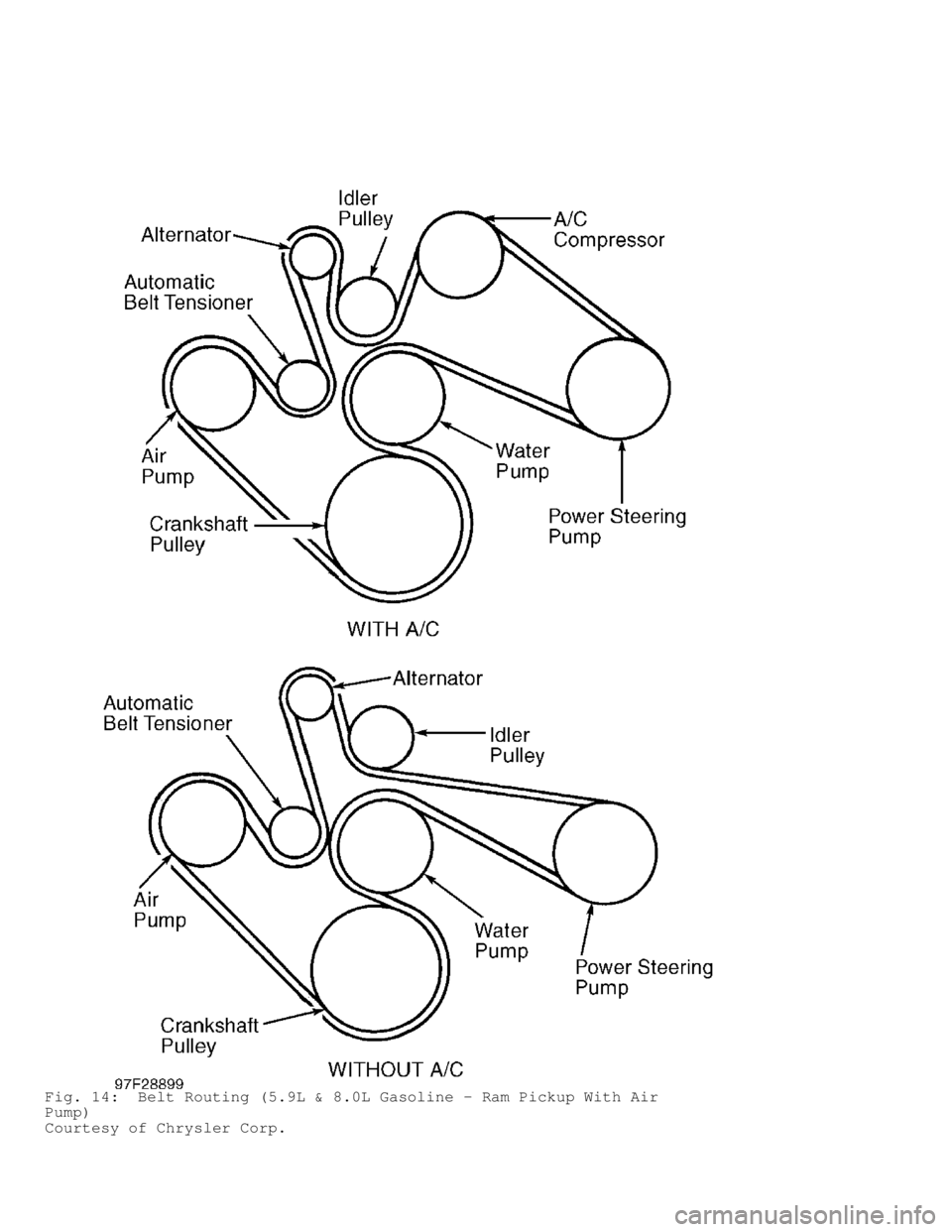
Fig. 14: Belt Routing (5.9L & 8.0L Gasoline - Ram Pickup With Air
Pump)
Courtesy of Chrysler Corp.
Page 634 of 1691
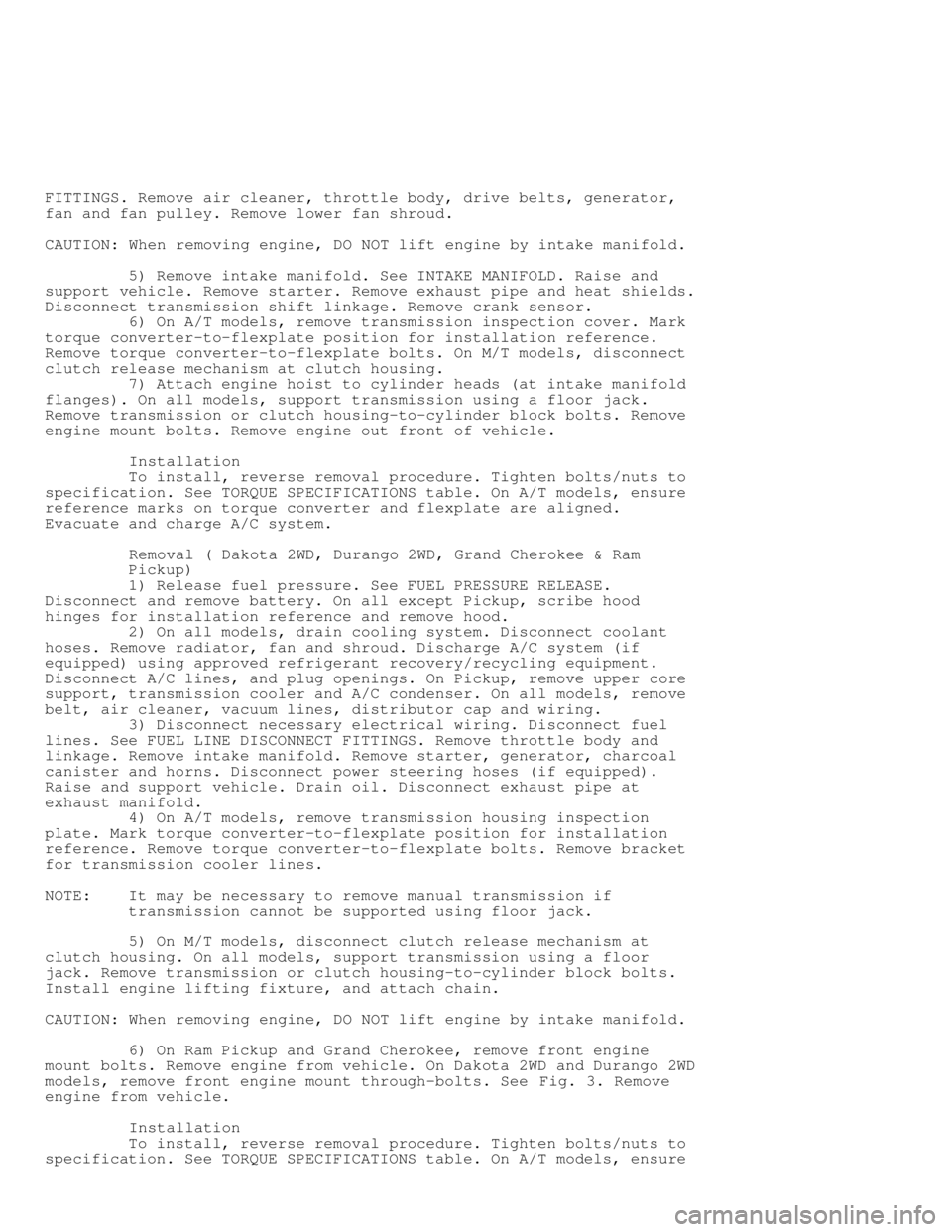
FITTINGS. Remove air cleaner, throttle body, drive belts, generator,
fan and fan pulley. Remove lower fan shroud.
CAUTION: When removing engine, DO NOT lift engine by intake manifold.
5) Remove intake manifold. See INTAKE MANIFOLD. Raise and
support vehicle. Remove starter. Remove exhaust pipe and heat shields.
Disconnect transmission shift linkage. Remove crank sensor.
6) On A/T models, remove transmission inspection cover. Mark
torque converter-to-flexplate position for installation reference.
Remove torque converter-to-flexplate bolts. On M/T models, disconnect
clutch release mechanism at clutch housing.
7) Attach engine hoist to cylinder heads (at intake manifold
flanges). On all models, support transmission using a floor jack.
Remove transmission or clutch housing-to-cylinder block bolts. Remove
engine mount bolts. Remove engine out front of vehicle.
Installation
To install, reverse removal procedure. Tighten bolts/nuts to
specification. See TORQUE SPECIFICATIONS table. On A/T models, ensure
reference marks on torque converter and flexplate are aligned.
Evacuate and charge A/C system.
Removal ( Dakota 2WD, Durango 2WD, Grand Cherokee & Ram
Pickup)
1) Release fuel pressure. See FUEL PRESSURE RELEASE.
Disconnect and remove battery. On all except Pickup, scribe hood
hinges for installation reference and remove hood.
2) On all models, drain cooling system. Disconnect coolant
hoses. Remove radiator, fan and shroud. Discharge A/C system (if
equipped) using approved refrigerant recovery/recycling equipment.
Disconnect A/C lines, and plug openings. On Pickup, remove upper core
support, transmission cooler and A/C condenser. On all models, remove
belt, air cleaner, vacuum lines, distributor cap and wiring.
3) Disconnect necessary electrical wiring. Disconnect fuel
lines. See FUEL LINE DISCONNECT FITTINGS. Remove throttle body and
linkage. Remove intake manifold. Remove starter, generator, charcoal
canister and horns. Disconnect power steering hoses (if equipped).
Raise and support vehicle. Drain oil. Disconnect exhaust pipe at
exhaust manifold.
4) On A/T models, remove transmission housing inspection
plate. Mark torque converter-to-flexplate position for installation
reference. Remove torque converter-to-flexplate bolts. Remove bracket
for transmission cooler lines.
NOTE: It may be necessary to remove manual transmission if
transmission cannot be supported using floor jack.
5) On M/T models, disconnect clutch release mechanism at
clutch housing. On all models, support transmission using a floor
jack. Remove transmission or clutch housing-to-cylinder block bolts.
Install engine lifting fixture, and attach chain.
CAUTION: When removing engine, DO NOT lift engine by intake manifold.
6) On Ram Pickup and Grand Cherokee, remove front engine
mount bolts. Remove engine from vehicle. On Dakota 2WD and Durango 2WD
models, remove front engine mount through-bolts. See Fig. 3. Remove
engine from vehicle.
Installation
To install, reverse removal procedure. Tighten bolts/nuts to
specification. See TORQUE SPECIFICATIONS table. On A/T models, ensure
Page 641 of 1691
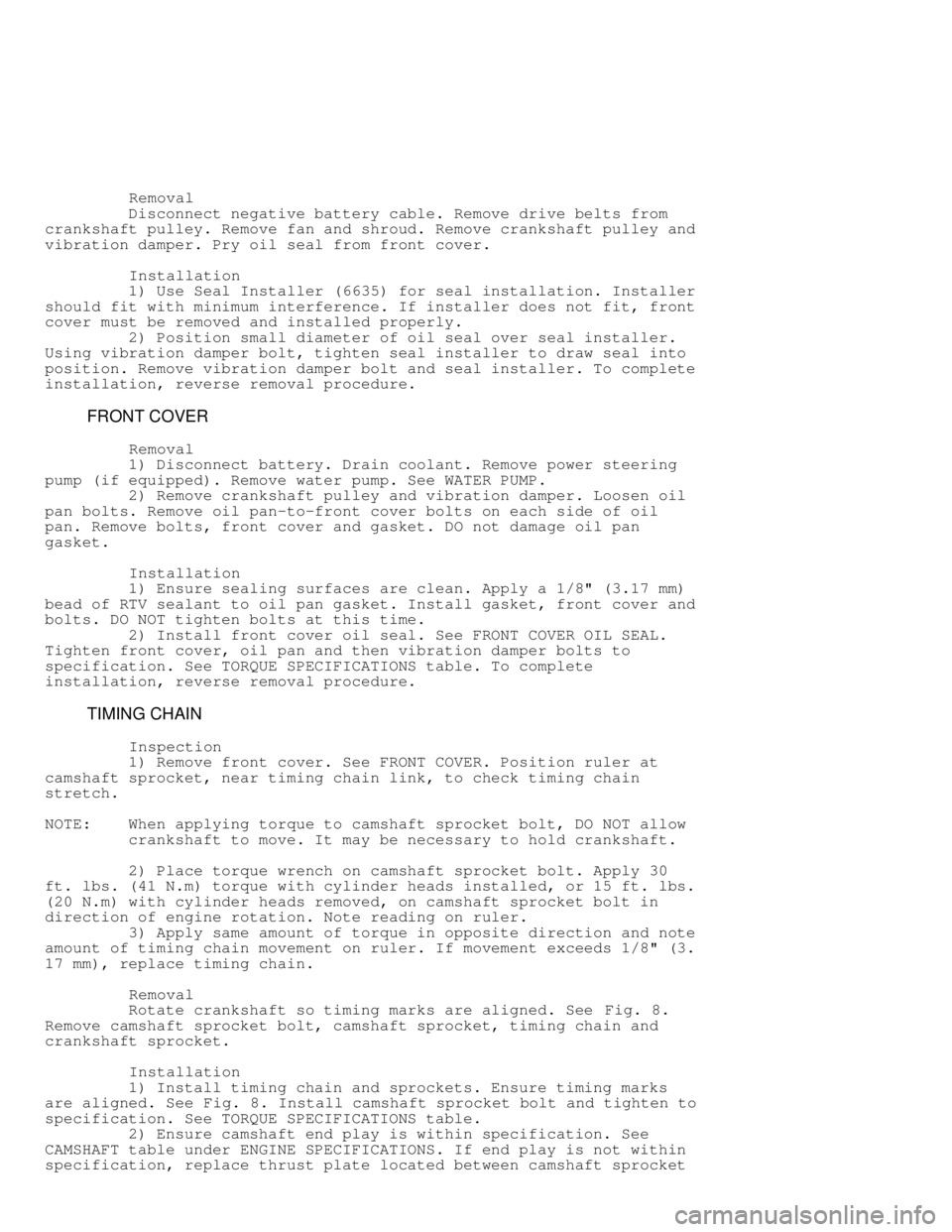
Removal
Disconnect negative battery cable. Remove drive belts from
crankshaft pulley. Remove fan and shroud. Remove crankshaft pulley and
vibration damper. Pry oil seal from front cover.
Installation
1) Use Seal Installer (6635) for seal installation. Installe\
r
should fit with minimum interference. If installer does not fit, front
cover must be removed and installed properly.
2) Position small diameter of oil seal over seal installer.
Using vibration damper bolt, tighten seal installer to draw seal into
position. Remove vibration damper bolt and seal installer. To complete
installation, reverse removal procedure.
FRONT COVER
Removal
1) Disconnect battery. Drain coolant. Remove power steering
pump (if equipped). Remove water pump. See WATER PUMP.
2) Remove crankshaft pulley and vibration damper. Loosen oil
pan bolts. Remove oil pan-to-front cover bolts on each side of oil
pan. Remove bolts, front cover and gasket. DO not damage oil pan
gasket.
Installation
1) Ensure sealing surfaces are clean. Apply a 1/8" (3.17 mm)\
bead of RTV sealant to oil pan gasket. Install gasket, front cover and
bolts. DO NOT tighten bolts at this time.
2) Install front cover oil seal. See FRONT COVER OIL SEAL.
Tighten front cover, oil pan and then vibration damper bolts to
specification. See TORQUE SPECIFICATIONS table. To complete
installation, reverse removal procedure.
TIMING CHAIN
Inspection
1) Remove front cover. See FRONT COVER. Position ruler at
camshaft sprocket, near timing chain link, to check timing chain
stretch.
NOTE: When applying torque to camshaft sprocket bolt, DO NOT allow
crankshaft to move. It may be necessary to hold crankshaft.
2) Place torque wrench on camshaft sprocket bolt. Apply 30
ft. lbs. (41 N.m) torque with cylinder heads installed, or 15 ft. lbs.\
(20 N.m) with cylinder heads removed, on camshaft sprocket bolt in
direction of engine rotation. Note reading on ruler.
3) Apply same amount of torque in opposite direction and note
amount of timing chain movement on ruler. If movement exceeds 1/8" (3.
17 mm), replace timing chain.
Removal
Rotate crankshaft so timing marks are aligned. See Fig. 8.
Remove camshaft sprocket bolt, camshaft sprocket, timing chain and
crankshaft sprocket.
Installation
1) Install timing chain and sprockets. Ensure timing marks
are aligned. See Fig. 8. Install camshaft sprocket bolt and tighten to
specification. See TORQUE SPECIFICATIONS table.
2) Ensure camshaft end play is within specification. See
CAMSHAFT table under ENGINE SPECIFICATIONS. If end play is not within
specification, replace thrust plate located between camshaft sprocket
Page 647 of 1691
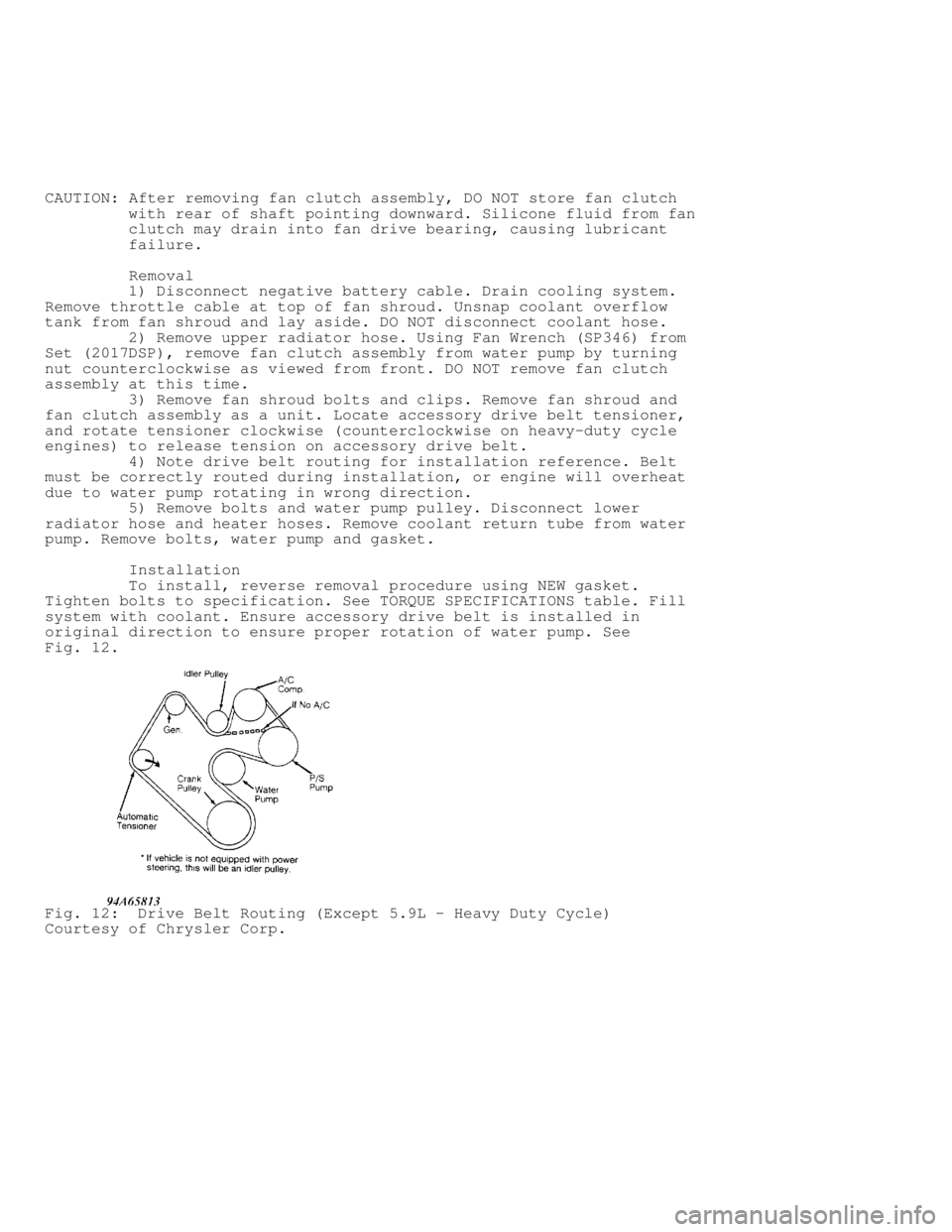
CAUTION: After removing fan clutch assembly, DO NOT store fan clutch
with rear of shaft pointing downward. Silicone fluid from fan
clutch may drain into fan drive bearing, causing lubricant
failure.
Removal
1) Disconnect negative battery cable. Drain cooling system.
Remove throttle cable at top of fan shroud. Unsnap coolant overflow
tank from fan shroud and lay aside. DO NOT disconnect coolant hose.
2) Remove upper radiator hose. Using Fan Wrench (SP346) from\
Set (2017DSP), remove fan clutch assembly from water pump by turning
nut counterclockwise as viewed from front. DO NOT remove fan clutch
assembly at this time.
3) Remove fan shroud bolts and clips. Remove fan shroud and
fan clutch assembly as a unit. Locate accessory drive belt tensioner,
and rotate tensioner clockwise (counterclockwise on heavy-duty cycle
engines) to release tension on accessory drive belt.
4) Note drive belt routing for installation reference. Belt
must be correctly routed during installation, or engine will overheat
due to water pump rotating in wrong direction.
5) Remove bolts and water pump pulley. Disconnect lower
radiator hose and heater hoses. Remove coolant return tube from water
pump. Remove bolts, water pump and gasket.
Installation
To install, reverse removal procedure using NEW gasket.
Tighten bolts to specification. See TORQUE SPECIFICATIONS table. Fill
system with coolant. Ensure accessory drive belt is installed in
original direction to ensure proper rotation of water pump. See
Fig. 12 .
Fig. 12: Drive Belt Routing (Except 5.9L - Heavy Duty Cycle)
Courtesy of Chrysler Corp.
Page 648 of 1691
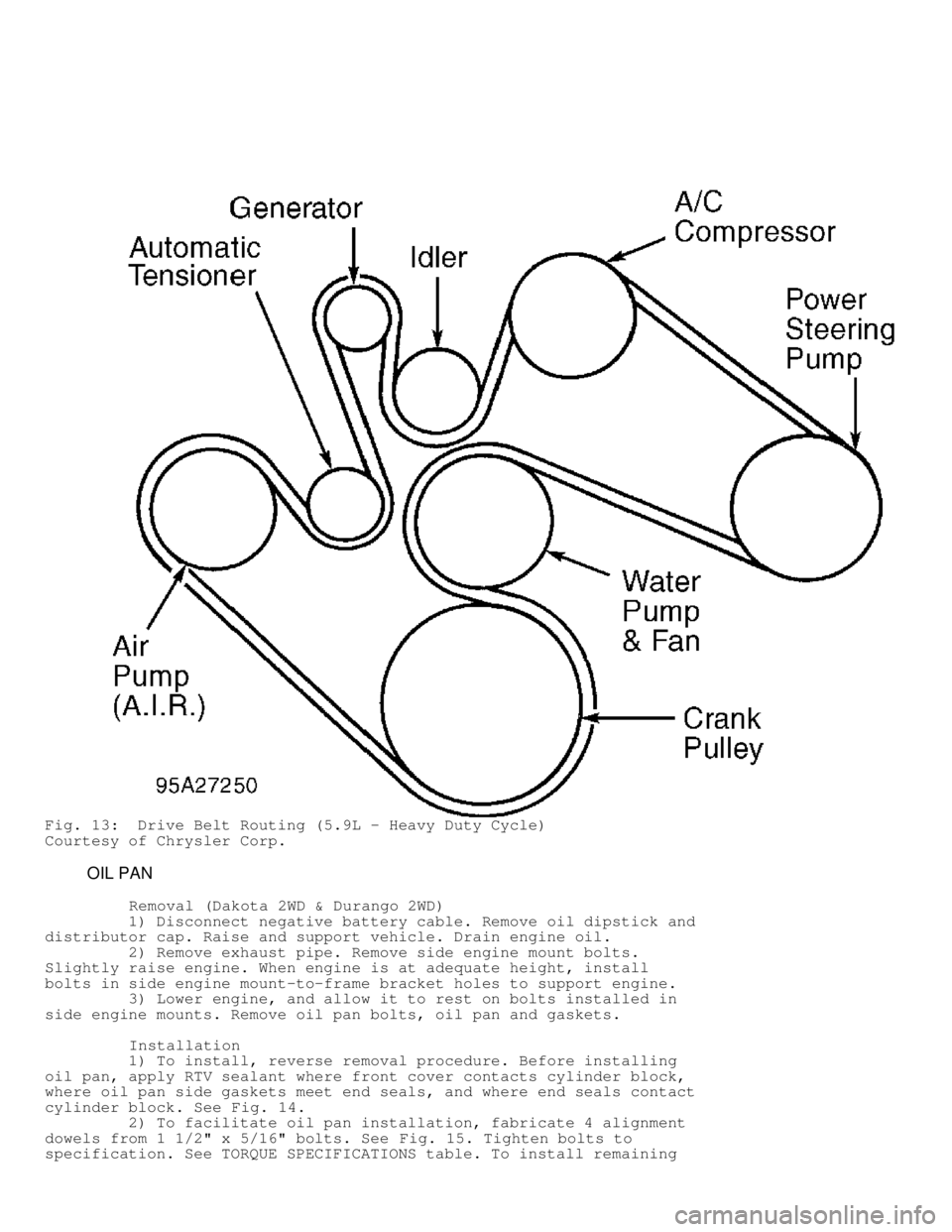
Fig. 13: Drive Belt Routing (5.9L - Heavy Duty Cycle)
Courtesy of Chrysler Corp.
OIL PAN
Removal (Dakota 2WD & Durango 2WD)
1) Disconnect negative battery cable. Remove oil dipstick and
distributor cap. Raise and support vehicle. Drain engine oil.
2) Remove exhaust pipe. Remove side engine mount bolts.
Slightly raise engine. When engine is at adequate height, install
bolts in side engine mount-to-frame bracket holes to support engine.
3) Lower engine, and allow it to rest on bolts installed in
side engine mounts. Remove oil pan bolts, oil pan and gaskets.
Installation
1) To install, reverse removal procedure. Before installing
oil pan, apply RTV sealant where front cover contacts cylinder block,
where oil pan side gaskets meet end seals, and where end seals contact
cylinder block. See Fig. 14.
2) To facilitate oil pan installation, fabricate 4 alignment
dowels from 1 1/2" x 5/16" bolts. See Fig. 15. Tighten bolts to
specification. See TORQUE SPECIFICATIONS table. To install remaining
Page 693 of 1691
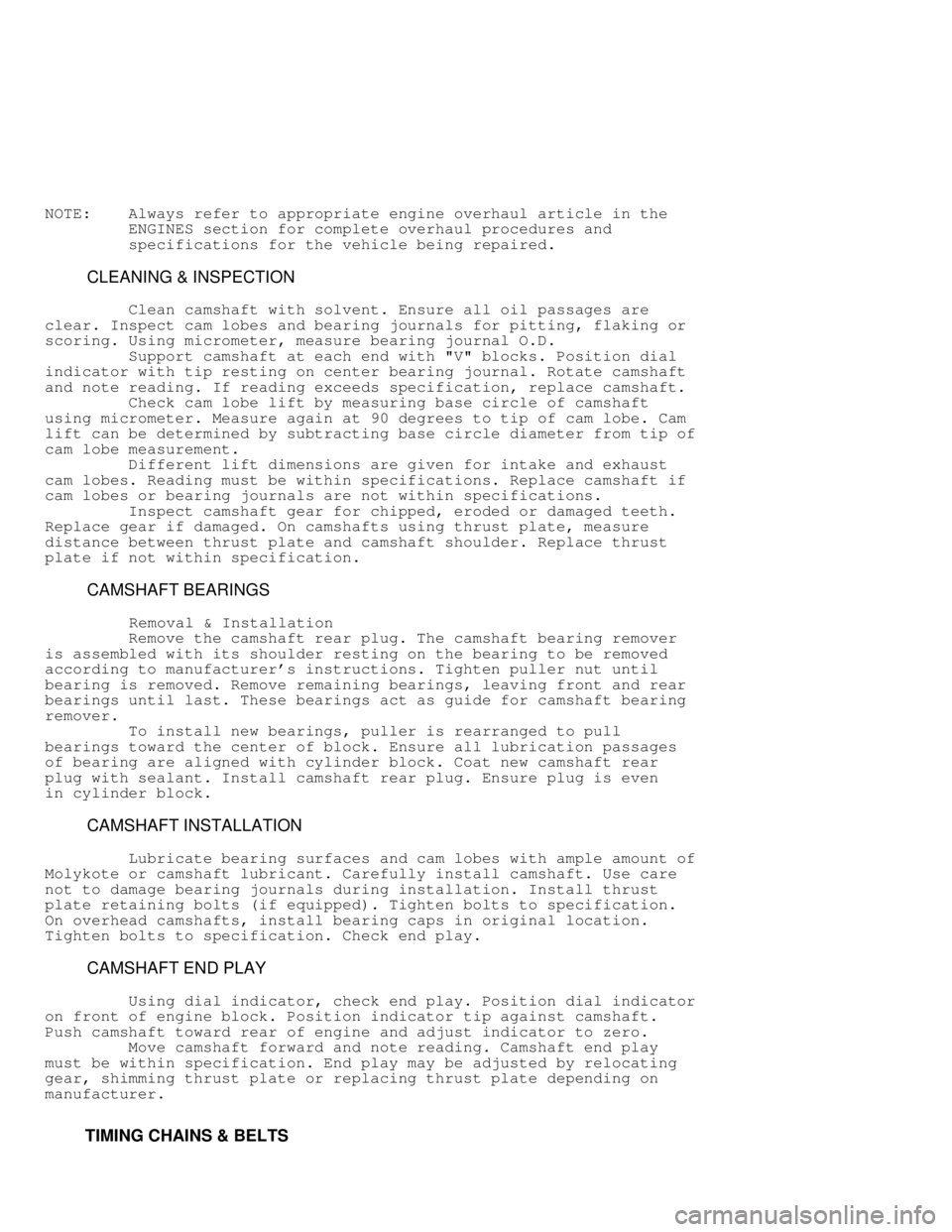
NOTE: Always refer to appropriate engine overhaul article in the
ENGINES section for complete overhaul procedures and
specifications for the vehicle being repaired.
CLEANING & INSPECTION
Clean camshaft with solvent. Ensure all oil passages are
clear. Inspect cam lobes and bearing journals for pitting, flaking or
scoring. Using micrometer, measure bearing journal O.D.
Support camshaft at each end with "V" blocks. Position dial
indicator with tip resting on center bearing journal. Rotate camshaft
and note reading. If reading exceeds specification, replace camshaft.
Check cam lobe lift by measuring base circle of camshaft
using micrometer. Measure again at 90 degrees to tip of cam lobe. Cam
lift can be determined by subtracting base circle diameter from tip of
cam lobe measurement.
Different lift dimensions are given for intake and exhaust
cam lobes. Reading must be within specifications. Replace camshaft if
cam lobes or bearing journals are not within specifications.
Inspect camshaft gear for chipped, eroded or damaged teeth.
Replace gear if damaged. On camshafts using thrust plate, measure
distance between thrust plate and camshaft shoulder. Replace thrust
plate if not within specification.
CAMSHAFT BEARINGS
Removal & Installation
Remove the camshaft rear plug. The camshaft bearing remover
is assembled with its shoulder resting on the bearing to be removed
according to manufacturer's instructions. Tighten puller nut until
bearing is removed. Remove remaining bearings, leaving front and rear
bearings until last. These bearings act as guide for camshaft bearing
remover.
To install new bearings, puller is rearranged to pull
bearings toward the center of block. Ensure all lubrication passages
of bearing are aligned with cylinder block. Coat new camshaft rear
plug with sealant. Install camshaft rear plug. Ensure plug is even
in cylinder block.
CAMSHAFT INSTALLATION
Lubricate bearing surfaces and cam lobes with ample amount of
Molykote or camshaft lubricant. Carefully install camshaft. Use care
not to damage bearing journals during installation. Install thrust
plate retaining bolts (if equipped). Tighten bolts to specification.
On overhead camshafts, install bearing caps in original location.
Tighten bolts to specification. Check end play.
CAMSHAFT END PLAY
Using dial indicator, check end play. Position dial indicator
on front of engine block. Position indicator tip against camshaft.
Push camshaft toward rear of engine and adjust indicator to zero.
Move camshaft forward and note reading. Camshaft end play
must be within specification. End play may be adjusted by relocating
gear, shimming thrust plate or replacing thrust plate depending on
manufacturer.
TIMING CHAINS & BELTS
Page 695 of 1691
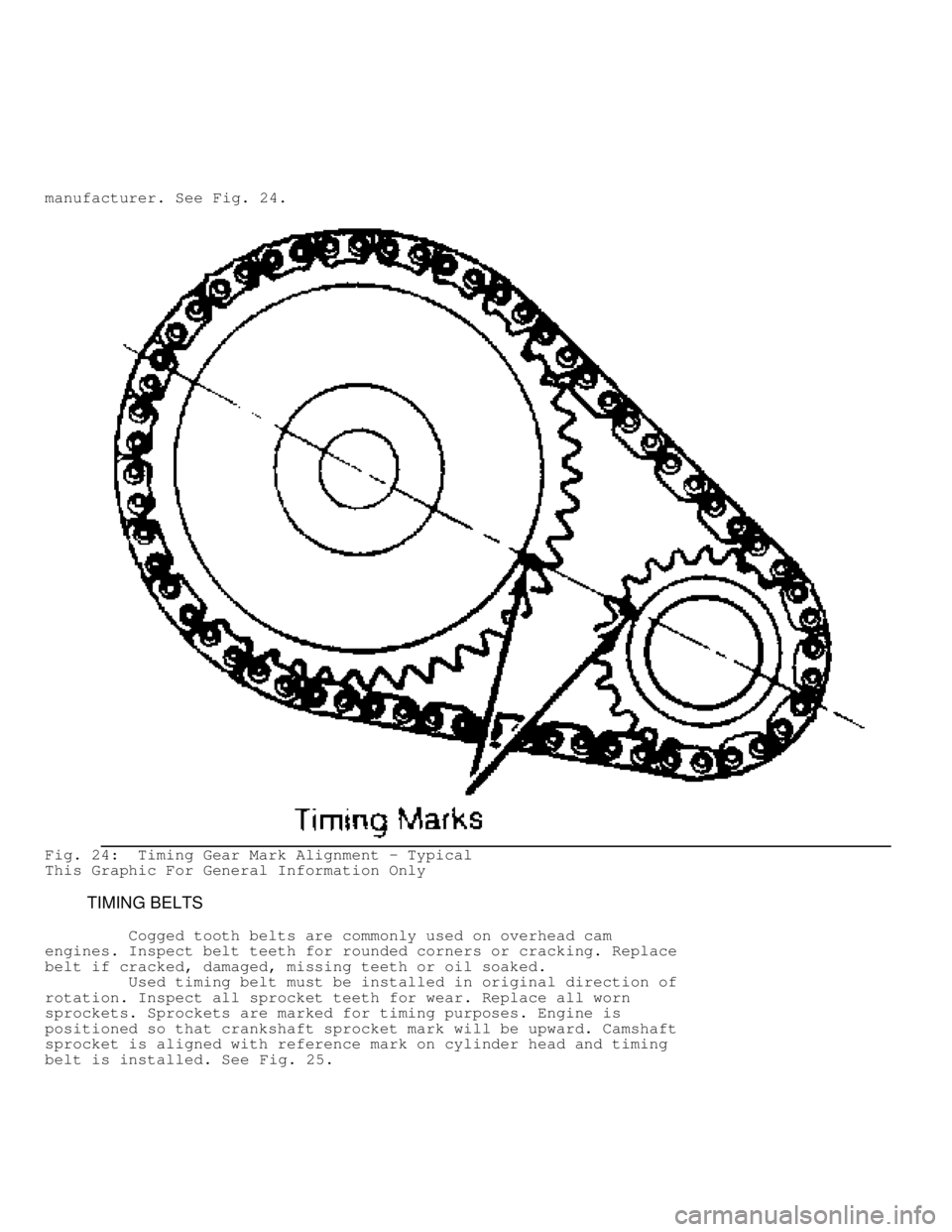
manufacturer. See Fig. 24.
Fig. 24: Timing Gear Mark Alignment - Typical
This Graphic For General Information Only
TIMING BELTS
Cogged tooth belts are commonly used on overhead cam
engines. Inspect belt teeth for rounded corners or cracking. Replace
belt if cracked, damaged, missing teeth or oil soaked.
Used timing belt must be installed in original direction of
rotation. Inspect all sprocket teeth for wear. Replace all worn
sprockets. Sprockets are marked for timing purposes. Engine is
positioned so that crankshaft sprocket mark will be upward. Camshaft
sprocket is aligned with reference mark on cylinder head and timing
belt is installed. See Fig. 25.